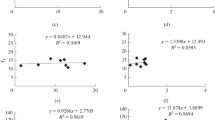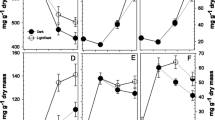Abstract
The influence of photoperiodic induction on the incorporation of uridine-3H into the shoot apices ofChenopodium rubrum was studied using the technique of autoradiography. No increase in uridine incorporation was detected either during induction lasting three days or immediately after its termination. Pyroninophylia likewise did not rise. However, changes in uridine incorporation related to morphogenetic activity during leaf formation and later during differentiation of inflorescences were well marked. The distribution of label in the nucleus immediately after three inductive cycles shows the ratio of extranucleolar to nucleolar incorporation to be higher in non-induced control plants than in induced ones.
Data from literature pointing to an activation of RNA synthesis during transition to flowering are discussed and compared with other systems where ontogenetic changes are accompanied by marked changes in RNA synthesis. It is assumed that the activation of RNA synthesis after induction is connected mainly with the activation of growth. However, inChenopodium rubrum photoperiodic induction proceeds together with limited growth and without activation of RNA synthesis.
Abstract
Metodou autoradiografie jsme studovali vliv fotoperiodické indukce na inkorporaci uridinu-3H do osních vrcholů. Nenalezli jsme průkazných rozdílů mezi indukovanými a neindukovanými rostlinami ani po třídenní fotoperiodické indukci, která plně postačuje k vyvolání květního stavu. Tím spíše jsme nemohli najít rozdíly ani v průběhu indukce. Nepozorovali jsme přitom ani zvýšení barvitelnosti pyroninem. Větší basofilie se projevila až v průběhu květní diferenciace.
Naproti tomu metoda autoradiografie velmi dobře umožnila sledování inkorporace uridinu do ruzných části meristemu v závislosti na jejich růstové aktivitě při zakládá ní listů a později při diferenciaci květenství.
Distribuce značení v jádře ukázala spíše na větší podíl jadé rkové inkorporace ve vrcholech indukovaných rostlin ve srovnání s rostlinami neindukovanými. Tento rozdíl byl z největší části dán zvětšením jadérka u indukovaných rostlin.
Jsou diskutovány nálezy aktivace syntézy RNA během přechodu ke kvetení a srovnány s jiný-mi systémy u niehž ontogenetieké změny jsou doprovázeny markantnimi změnami v syntéze RNA Je vysloven názor, že aktivace syntézy RNA souvisí především s aktivací růstu. UChenopodium rubrum fotoperiodická indukce probíhá při omezeném růstu a bez aktivace syntézy RNA.
Similar content being viewed by others
References
Amano, A.: Metabolism of RNA in the liver cells of the rat. II. Chemical snalysis of RNA in cellular components. —Exp. Cell Res.46: 180–190, 1967.
Barlow, P. W.: RNA synthesis in the root apex ofZea mays. — J.exp. Bot.21: 292–299, 1970.
Bernier, G., Kinet, J.-M., Bronchart, R.: Cellular events at the meristem during floral induction inSinapis alba.—Physiol. vég.5: 311–324, 1967.
Bronchart, R., Bernier, G., Kinet, J.-M., Havelange, A.: RNA synthesis in the cells of the apical meristem ofSinapis alba during transition from vegetative to the reproductive condition. —Planta91: 255–269, 1970.
Broughton, W. J.: Relations between DNA, RNA and protein synthesis and the cellular basis of the growth response in gibberellic acid-treated pea internodes.—Ann. Bot. (N.S.)33:227–243 1969.
Brown, D. D., Littna, E.: RNA synthesis during the development ofXenopus laevis, the South African claved toad.—J.mol.Biol.8: 669–687, 1964.
Bucknall, R. A., Sutcliffe, J. F.: The nucleic acids and cellular differentiation in the root apex ofPisum sativum. II. The nucleic acids and cellular development patterns.—J. exp. Bot.16: 587–603, 1965.
Cherry, J. H., vanHuystee, R. B.: Comparison of messenger RNA in photoperiodically induced and noninducedXanthium buds.—Science150: 1450–1453, 1965.
Chrispels, M. J., Varneb, J. E.: Hormonal control of enzyme synthesis: On the mode of action of action of gibberellic acid and abscisin in aleurone layers of barley.—Plant Physiol.42: 1008–1016, 1967.
Church, R. B., McCabthy, B. J.: Ribonucleic acid synthesis in regenerating and embryonic liver. II. The synthesis of RNA during embryonic liver development and its relationship to regenerating liver. —J. mol. Biol.23: 477–486, 1967.
Comb, D. G., Katz, S., Branda, R., Pinzino, J. C: Characterization of RNA species synthesized during early development of sea urchins.—J.mol.Biol.14: 195–213, 1965.
Denis, H.: Gene expression in amphibian development. II. Release of the genetic information in growing embryos.— J.mol.Biol.22: 285–304, 1965.
Evans, L. T., Knox, R. B., Rijven, A. H. G. C.: The nature and localization of early events in the shoot apex ofLolium temulentum during floral induction.—In:Bernier, G. (ed.): Cellular and Molecular Aspects of Floral Induction. Pp. 192–205. Longman, London 1970.
Gifford, B. M., Tepper, H. B.: Ontogeny of the inflorescence inChenopodium rubrum.—Amer. J.Bot.48: 657–667, 1961.
Greene, R. F., Flickinger, R. A.: Qualitative changes in DNA-like RNA during development inRana pipiens.—Biochim. biophys. Acta217: 447–460, 1970.
Healey, P. L., Jensen, W. A. Changes in ultrastructure and histochemistry accompanying floral induction in the shoot apex ofPharbitis.—Amer.J.Bot.52: 622, 1965.
Heslop-Habrison, J., Heslop-Harrison, Y.: The state of the apex and the response to induction inCannabis sativa.—In:Bernier, G. (ed.) Cellular and Molecular Aspects of Floral Induction. Pp. 3–25. Longman, London 1970.
Jarvis, B. C., Frankland, B., Cherry, J. H.: Increased DNA template and RNA polymerase associated with the breaking of seed dormancy.—Plant Physiol.43: 1734–1736, 1968.
Lyndon, R. F.: DNA, RNA, and protein in the pea shoot apex in relation to leaf initiation.— J.exp. Bot.21: 286–291, 1970.
Masxjda, Y., Tanimoto, E.: Effect of auxin and antiauxin on the growth and RNA synthesis of etiolated pea internode. - Plant Cell Physiol.8: 459–465, 1967.
Nougarède, A.: Experimental cytology of the shoot apical cells during vegetative growth and flowering.—Rev. Cytol.21: 203–252, 1967.
Nougarède, A., Beonchart, R.: Le métabolisme des acides nucleiques au cours des diverses phases du développement dans le méristeme duPerilla nankinensis. —Bull.Soc.Fr. Physiol.vég.11: 149–154, 1965.
Perry, R. P.: The cellular synthesis of ribosomal and 4S RNA.—Proc. nat. Acad. Sci. U. S. A.48: 2179–2186, 1962.
Petersen, R. O., Baserga, R.: Nucleic acid and protein synthesis in cardial muscle of growing and adult mice.—Exp.Cell Res.40: 340–352, 1965.
Seidlová, F.: Inhibition of flowering ofChenopodium rubrum L. after the action of actinomycin D. — Biol.Plant.10: 318–321, 1968.
Seidlová, F.: Autoradiography of tritiated uridine in shoot apices ofChenopodium rubrum.— Biol.Plant.13: 189–192. 1971.
Seidlová, F., Krekule, J.: Growth effects of 2-thiouracil and possibility of selective inhibition of floral differentiation inChenopodium rubrum L.—Biol. Plant.10: 41–50, 1968.
Seidlová, F., Štichová, J.: Development of the shoot apex ofChenopodium rubrum L. after photoperiodic induction in the cotyledon stage.—Biol.Plant.10: 131–134, 1968.
Tuan, D. Y. H., Bonner, J.: Dormancy associated with repression of genetic material.—Plant Physiol.39: 768–772, 1964.
Watson, J. D., Matthews, R. E. F.: Effect of actinomycin D and 2-thiouracil on floral induction and nucleic acid synthesis in the bud ofChenopodium amaranticolor.—Aust. J.biol.Sci.19: 967–980, 1966.
Waters, L. C., Dure, L. S.: Ribonucleic acid synthesis on germinating cotton seeds.—J. mol. Biol.19: 1–27, 1966.
Author information
Authors and Affiliations
Rights and permissions
About this article
Cite this article
Seidlová, F. The incorporation of uridine-3H into the shoot apices of photoperiodically induced and non-induced plants ofChenopodium rubrum L.. Biol Plant 14, 241–248 (1972). https://doi.org/10.1007/BF02935847
Received:
Published:
Issue Date:
DOI: https://doi.org/10.1007/BF02935847




